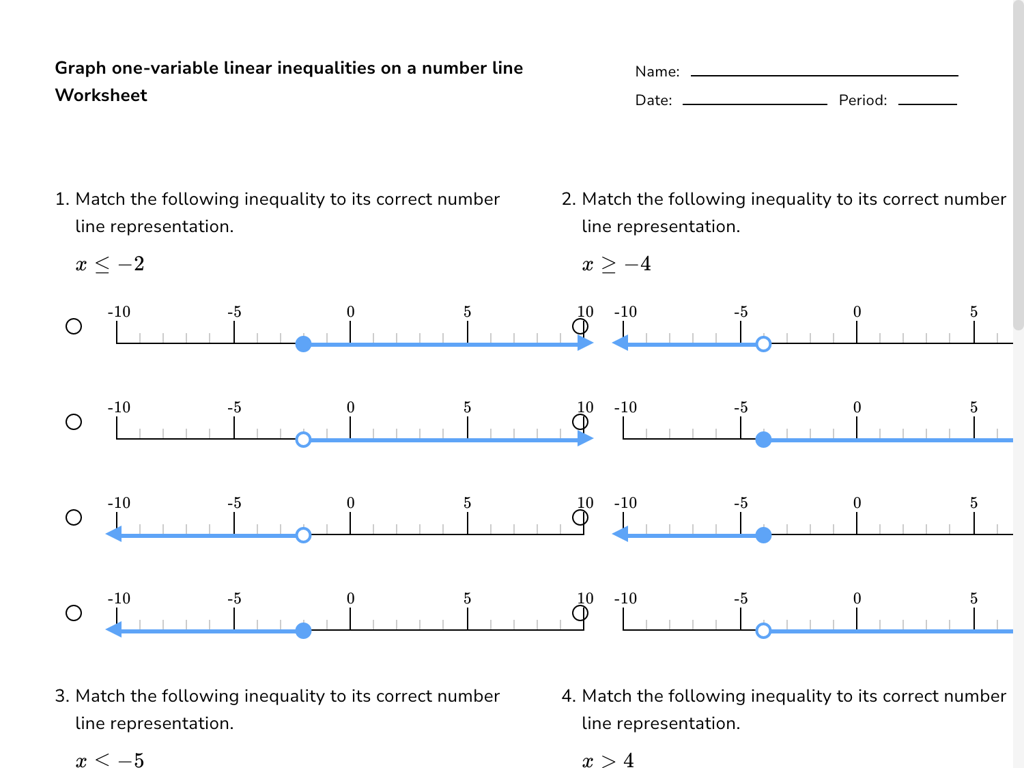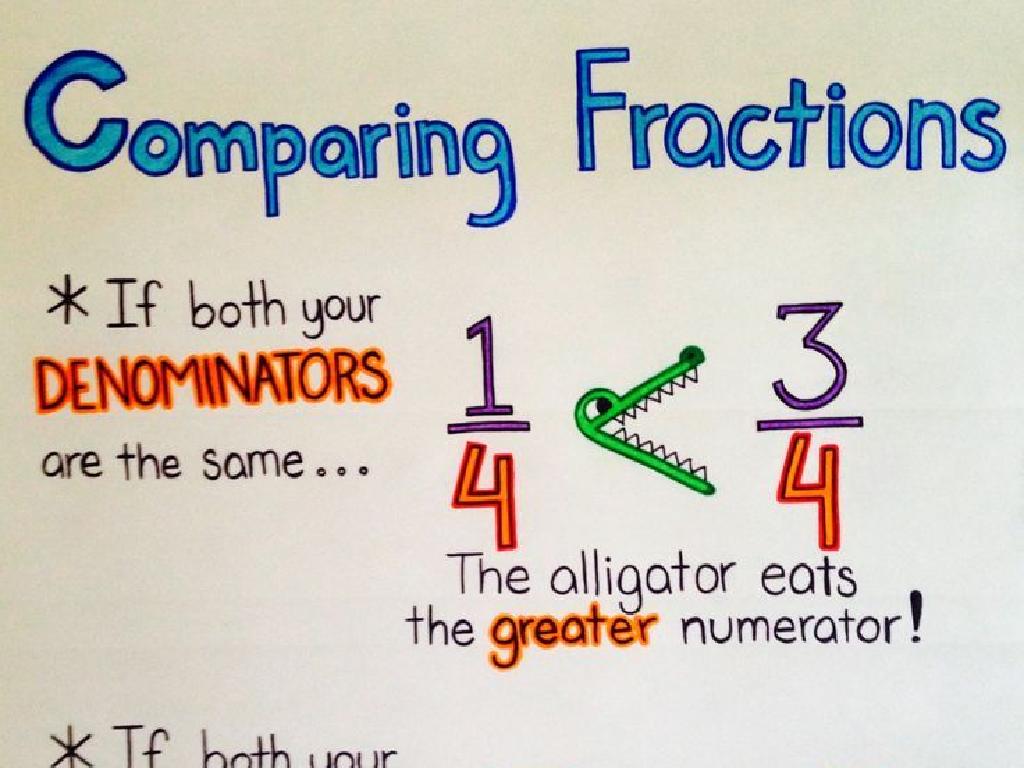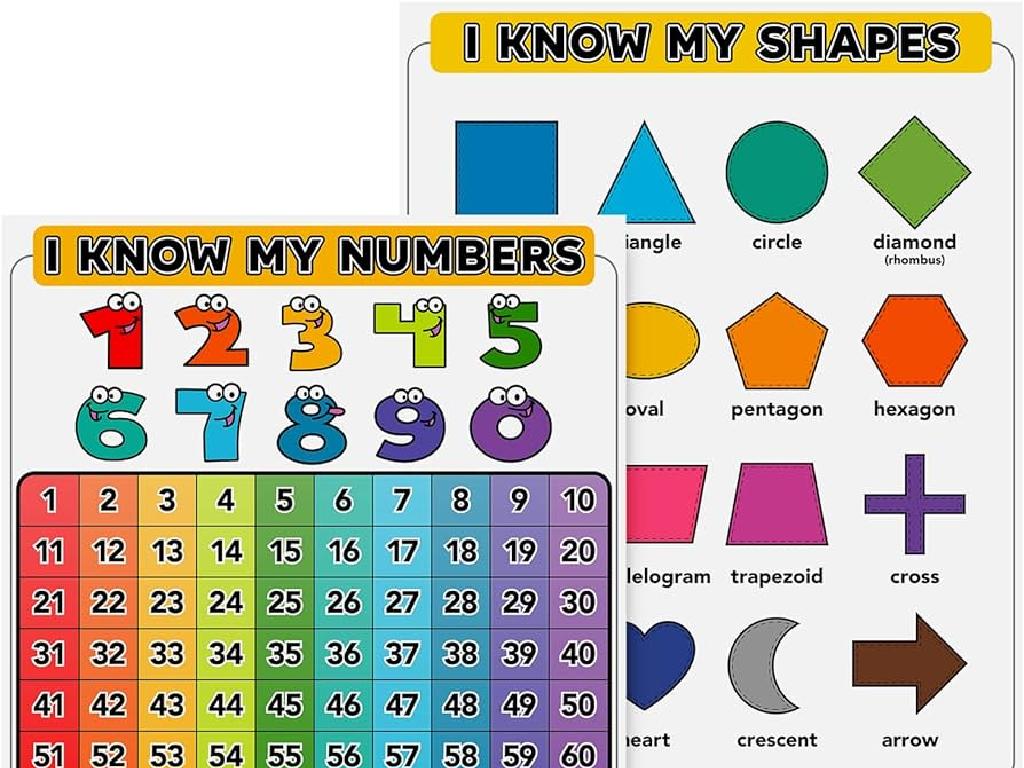Add And Subtract Integers: Find The Sign
Subject: Math
Grade: Sixth grade
Topic: Operations With Integers
Please LOG IN to download the presentation. Access is available to registered users only.
View More Content
Adding and Subtracting Integers: Finding the Sign
– Understand what integers are
– Integers include positive, negative numbers, and zero
– Learn to add and subtract integers
– Use rules for adding and subtracting positive and negative numbers
– Determine the sign of the result
– The sign of the result depends on the numbers involved
– Practice with examples
– Try 5 + (-3) and 4 – (-2) to see how it works
|
This slide introduces students to the concept of integers and the rules for adding and subtracting them. Start by explaining that integers are whole numbers that can be positive, negative, or zero. Then, discuss the rules for combining these numbers, such as ‘two negatives make a positive’ when subtracting, and ‘add the opposite’ when dealing with negative numbers. Emphasize the importance of finding the sign of the result, which can be determined by looking at the numbers being added or subtracted. Provide examples and encourage students to solve them to reinforce their understanding. This foundational knowledge is crucial for their success in algebra and higher-level math.
Understanding Integers and Their Signs
– Define integers
– Integers include whole numbers, their negatives, and zero
– Positive vs. negative numbers
– Positive numbers are above zero, negative numbers are below
– Real-life integer examples
– Temperatures, bank balances, and elevations can be integers
– Finding the sign in operations
– When adding/subtracting, determine if result is positive or negative
|
Integers are the set of whole numbers and their opposites, including zero. It’s crucial for students to understand the difference between positive and negative numbers, as this concept is foundational for operations with integers. Use relatable examples such as temperature changes, bank account deposits and withdrawals, or above/below sea level to illustrate integers in real life. When performing operations like addition and subtraction, students should learn to find the sign of the result by considering the values and signs of the numbers involved. This slide will set the stage for further exploration into adding and subtracting integers.
Rules for Adding Integers
– Adding same sign integers
– Keep the sign, add the numbers: e.g., -3 + (-2) = -5
– Adding different sign integers
– If signs differ, use the sign of the larger number: e.g., -5 + 3 uses the sign of -5
– Keep sign of larger number
– When adding opposites, the larger absolute value dictates the sign
– Subtract smaller from larger
– Subtract absolute values and keep the sign of the larger: 7 + (-9) = -2
|
When teaching students to add integers, start by explaining the rules for same sign addition, which is straightforward as they keep the sign and add the numbers. For different sign addition, guide them to understand that the sign of the larger absolute value number will be the sign of the answer. They should subtract the smaller absolute value from the larger one to find the result. Use examples to illustrate these rules, and provide practice problems that help them apply these concepts. Encourage students to think of real-life scenarios where they might add integers with different signs, such as temperatures or financial transactions.
Practice: Adding Integers
– Example 1: 5 + (-3)
– Positive plus a negative, think of gaining and losing
– Example 2: -7 + 2
– Negative plus a positive, like a debt reduced by a payment
– Pair up for class activity
– Solve 5 addition problems together
|
This slide is focused on practicing the addition of integers, which is a fundamental skill in understanding mathematics. Start by going through the examples provided. For Example 1, explain that adding a negative number is like losing something, so 5 + (-3) is like having 5 and then losing 3, which equals 2. For Example 2, show that -7 + 2 is like having a debt of 7 and paying back 2, so you still owe 5. After discussing the examples, have the students pair up and solve 5 additional problems. This activity encourages collaboration and allows students to apply what they’ve learned. Provide a mix of problems with different integer signs to ensure they practice a variety of scenarios. As a teacher, walk around the classroom to assist pairs that might be struggling and to check for understanding among the students.
Rules for Subtracting Integers
– Subtracting a positive moves left
– Example: 5 – 3, start at 5, move 3 steps left to 2
– Subtracting a negative moves right
– Example: 7 – (-2), start at 7, move 2 steps right to 9
– Subtracting is adding the opposite
– Instead of 6 – 4, think of it as 6 + (-4)
– Practice with number line activities
|
This slide introduces the basic rules for subtracting integers, emphasizing the use of the number line as a visual aid. When subtracting a positive number, we move to the left, which decreases the value. Conversely, subtracting a negative number, which is the same as adding its positive counterpart, moves us to the right, increasing the value. Reinforce the concept that subtraction of integers can always be thought of as adding the opposite. Provide students with number line diagrams to practice these concepts, ensuring they understand the direction of movement for each operation. Encourage them to visualize the number line in their minds as they work with integers.
Practice: Subtracting Integers
– Subtracting a negative is adding
– When we subtract a negative, like 6 – (-4), it’s the same as 6 + 4.
– Subtracting a positive from a negative
– For -8 – 3, think of owing $8 and spending $3 more.
– Pair up for practice problems
– Solve 5 subtraction problems together
– Work with a partner to solve problems and compare strategies.
|
This slide is focused on practicing the subtraction of integers. Start by explaining that subtracting a negative number is the same as adding its positive counterpart. Use the example 6 – (-4) to illustrate this concept. Then, discuss what happens when we subtract a positive number from a negative one, using -8 – 3 as an example. Emphasize that this is like increasing a debt or deficit. For the class activity, have students pair up and solve 5 subtraction problems. Provide a mix of problems with different types of integer subtractions. Encourage students to discuss their thought process and how they determine the sign of the answer. This activity will help reinforce their understanding through collaboration and discussion.
Finding the Sign of the Result
– Predicting the sign
– Use number line concepts to predict if the result will be positive or negative
– Rules for determining the sign
– Positive + Positive = Positive, Negative + Negative = Negative, Positive + Negative = Depends on which is larger
– Significance of the sign
– Understanding the sign helps in real-world math like banking or temperatures
– Practice with examples
– Try examples: -3 + 7, -5 – (-2), 4 – 10 to apply the rules
|
This slide introduces students to the concept of predicting the sign of an integer operation before performing the calculation. Emphasize the importance of understanding the rules for adding and subtracting integers to determine whether the result will be positive or negative. Explain how this skill is applicable in real-life scenarios, such as managing money or measuring temperature changes. Provide practice examples and encourage students to use a number line for visualization. The teacher should prepare additional examples for in-class activities, ensuring students grasp the concept of finding the sign.
Group Activity: Sign Scavenger Hunt
– Explore classroom for integer operations
– Predict the sign of the results
– Is the result positive or negative?
– Solve the integer operations
– Use rules for adding and subtracting integers
– Discuss findings with the class
|
This interactive group activity is designed to help students apply their knowledge of integers in a practical setting. Students will work in small groups to locate examples of integer operations within the classroom environment. They might find temperatures, pages in books, or measurements that involve integers. Before calculating the answers, they should predict whether the result will be positive or negative, reinforcing the concept of integer signs. After solving, each group will share their examples and findings with the class, fostering a collaborative learning experience. As a teacher, facilitate the activity by providing hints of where to look and ensuring each group participates. Possible variations include using flashcards, a timed challenge, or incorporating integer operations found in recent homework assignments.
Conclusion & Homework: Mastering Integer Operations
– Recap adding & subtracting integers
– Grasp the significance of signs
– Positive & negative signs determine value direction
– Complete the integer worksheet
– Practice problems to solidify understanding
– Be prepared to discuss solutions
– Share your answers and methods in the next class
|
This slide wraps up the lesson on adding and subtracting integers, emphasizing the importance of understanding the signs, which dictate the direction of value – whether an amount is gained or lost. The homework assignment is a worksheet designed to reinforce the day’s learning. Encourage students to attempt all problems and remind them that making mistakes is a part of the learning process. For the next class, students should be ready to discuss the solutions, explaining how they arrived at their answers and the significance of the signs in each operation. This discussion will help clarify any misunderstandings and solidify their grasp of integer operations.






